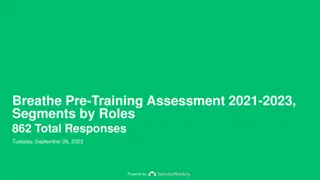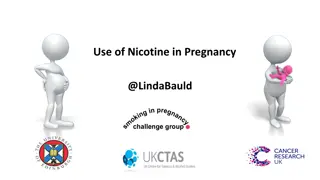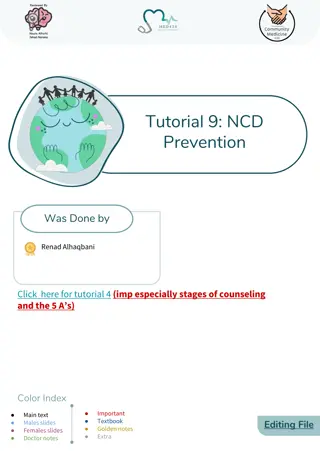Modified Smoking Provocation Training Session Analysis
An analysis of the existing provocation and the ratings on the Nicotine Craving Scale before and after the provocation cue suggested the need for modification. The extended provocation now includes specific triggers to enhance the craving experience. Standardized procedures ensure the effectiveness of the modified session.
Download Presentation

Please find below an Image/Link to download the presentation.
The content on the website is provided AS IS for your information and personal use only. It may not be sold, licensed, or shared on other websites without obtaining consent from the author.If you encounter any issues during the download, it is possible that the publisher has removed the file from their server.
You are allowed to download the files provided on this website for personal or commercial use, subject to the condition that they are used lawfully. All files are the property of their respective owners.
The content on the website is provided AS IS for your information and personal use only. It may not be sold, licensed, or shared on other websites without obtaining consent from the author.
E N D
Presentation Transcript
Student Equity Plan 2.0 Steps to Develop Equity Plan
Summary of Groups Disproportionately Impacted 2. Retention: Fall to Spring 3. Completion both Transfer Level Math and English with the district in the first year Group Successful Enrollment (Access Applied and actually enrolled) 1. Transfer to four-year institution 4. Earned one or more of the following: Chancellor's Office approved certificate, associate degree, and/or CCC baccalaureate degree Latinx X X African American X X 25-29 years old X X 30-34 years old X X 40-54 years old X X Not Eligible for College Promise Grant/BOG Waiver X X X Never Received PELL Grant X X X Not Perkins Economically Disadvantaged X X X
Summary of the Center for Urban Education (CUE) Review of Crafton s Previous Student Equity Plan Prioritizes the use of data and research to inform and evaluate the effectiveness of activities Plan is data driven Data has been collected and analyzed to determine which services were most effective in improving success for DI students Example: Supplemental instruction was found to positively impact course success for Hispanic students and tutoring was most effective with male, Hispanic, and African American students Plan also included activity to research the gaps that exist to deepen the understanding of why DI exists
Center for Urban Educations (CUE) recommendations for Crafton Focus on specific racially minoritized student populations rather than on all students. Create equity activities that explicitly align the race-specific metrics to race-specific activity descriptions (Example: The college will conduct targeted outreach activities to increase the number of African American and LGBTQ students that complete the matriculation process.) Adopt equity-minded language, including operationalizing a definition of equity for the college. Include transfer-specific equity activities. Align equity planning with Vision for Success More classroom specific activities the primary aim of the activity is focused on what happens in the classroom like training faculty on equitable classroom practice
SEAC Committee Aligned outcomes with committees, departments, and groups
Approach to including entire campus to develop equity activities Align outcomes with committees, departments, and groups Present this presentation to each committee and group and review activity template Review data, CUE recommendations, and research identifying which activities are effective with which DI Groups Send out instructions to identified groups Review the data Review the research identifying which activities are effective with which DI groups Provide activities to increase outcomes (and remove gaps) that are specific to DI groups Design teams will review activities developed by the committees, departments, and groups and align each activity with the GP Pillars and ensure that the CUE recommendations are being incorporated























